 |

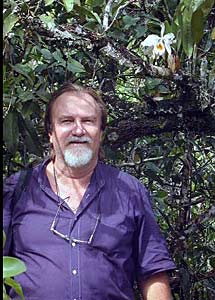 |
Pedro
Ivo Soares Braga is graduated in Natural History, Master in Botany and
Doctor in Biological Sciences. Expert in the flora of the Amazon region where he has been doing his researches since 1974. He had a vast bibliography of publications concerning the flora in general and, specially, the Orchidaceae family Successively, he has been researcher and professor at the National Institute of Amazon Researches, professor of the Botanical Department of University of Minas Gerais, later and until now, Professor of the Botanical Department of the Federal University of Amazonas, em Manaus. |
|
ON: Pedro Ivo, when and how did you start to be interested
in the study of orchids?
PI:
Since I was a kid, I always liked the nature and went frequently to
the country. |
ON:
Which is your academic formation? PI: I am graduated in Natural History and have taken the Bachelor. By this time, there wasn't the Course on Biological Sciences, until then, the course of Natural History was given by the High Scholl of Philosophy, Sciences and Literature. After finishing the graduation, I did the post-graduation in the “sensu strictu”, first I got the title of Master and then the doctorate. Besides, I did many excursions, with many botanists, in the states of Paraná, São Paulo, Rio de Janeiro, Espírito Santo, Minas Gerais, Brasilia and Panama. Between them I can mention Doctors Lyman B. Smith (Bromeliaceae), Father Leopoldo Krieger (floristic), Carlos Toledo Rizzini (Phytogeography), Edgard Kuhlmann (Phytogeography), Gerhard Gottsberger (Monnimiaceae and Vegetal Biology), Helen Kennedy (Maranthaceae and Floral Biology), Robert Dressler (Orchidaceae and Floral Biology), Tom Sordestron (Gramineae), among others with who I could know the several aspects of the Botany. |
ON: Guido Pabst had a great influence on your passion for orchids, how did meet him? PI: I first met him when I was studying the BGRJ. He and Dr. Edmund founded the Bradeanum Herbarium and Guido Pabst came to see him very often. One day, he gave a lesson about orchids and finished for adopting me as his scientific son. As he was moving to São Paulo, we started to interchange letters, at about 10 letters a week. He sent me works, I did some questions and went the week-end to study in his home. I left Rio on Friday and return on the Monday, it lasted for 2 years. I finished for publishing my first work about orchids before finishing the high school. It was Rodriguezia sucrei, collected in the state of Rio de Janeiro (Cabo Frio). Pabst and I have also described a Rauhiella brasiliensis, which is an orchid published in German, a genus that is not well known. After that Francisco Miranda described another species in Friburgo. |
| ON: When and why you choose the Amazon region to develop your studies? |
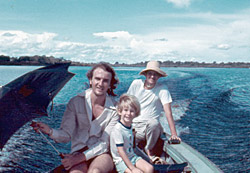 Rio Negro - 1974 |
PI:
Besides my father, I had an uncle that told many histories about the
Amazon. I should have to know it, I had a great attraction for Amazon.
In l973, when I finished the high school, I got married and at the beginning of l974, I moved. I had a scholarship from CNPq (National Council of Scientific Researches), I got the titles of Master and Doctorate in Orchids. Besides the course, the opportunity of working in the Brazilian Amazon was fascinating. I got the title of Master in l976 and the best student were invited to work at the National Institute of Amazon Researches - INPA. |
There
I couldn't just work with orchids, I should did the survey of the botanical
collections. I did many excursions in the Brazilian Amazon. Those journeys helped me to enlarge my studies in taxonomy, vegetal systemic and phytogeography. Those excursions were sponsors by the bilateral conventions with United States and German, between others. Of course, always collecting orchids. In 1979, a forest political for the Brazilian Amazon has been established when I worked as an assistant for the director of INPA and got involved with environmental questions. In l982, I got my doctorate, became the coordinator of the post-graduation until July l985, when I did an exam to get in the Federal University of Minas Gerais (UFMG). |
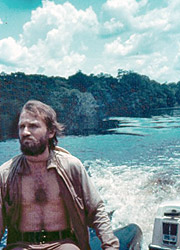 Igapó in Negro river - 1977 |
ON: It means, you stayed there for 12 years. The researchers Francisco Miranda and Kleber Lacerda went to there by the same time? PI: My thesis was published in the newspaper and many orchidists came to me. They came to my house or to INPA and I introduced one to another, so we decided to found the Amazon orchidists society. Kleber was the president, I was the scientific director and João Batista F. da Silva, our secretary. We had a bulletin which was typewritten, everything was done by hand. No computer, no text editor. It was imprinted in the print-shop the University of Amazonas. Manoela F. F. da Silva (From Goeldi Museum-Pará) came to get the title of Master at the INPA and João Batista, her husband, came with her. Francisco Miranda studied with me in Manaus and I oriented his thesis. When I went to Minas, he returned to Rio and Pedro Carauta orientated him at the National Museum and taught him nomenclature and he got an excellent botanical formation. But, he had already a very good base, he is really good in Botany. |
ON: This period was very rich in terms of researches, until then, we had no exactly idea about the number of species of orchids occurring in the Amazon region. PI: Yes, when I got there, in the INPA herbarium, for the area I have studied, there were 15 plants. When I finished my thesis, there were, 31. During the doctorate, there were 156 species from the "campina" (dryland) which represents the half of species of Amazon (at about 300 species). ON: The whole Amazon? PI: Yes, there always are the nomenclatural problems, without the synonmies, there are at about 400. However, I bet the number will arise because of new collections in the phytogeography of the Amazon. ON: In Minas Gerais, you went on working with orchids? PI:
At the University, you can't be only an orchidist or orchidologist because
you are searched for everything. I helped to create the course in Ecology,
Conservation and Handling of Wild Life and I stayed as a responsible
for the Department of Botany. There, I gave orientation for a thesis
about the phytosociology of the plants in the cerrado (savanna), about
the phytosociology of the rupestrian champs in the Serra (mountain)
do Cipó (supported the Boticario Foundation), and another in
floral biology of the Constantia cipoensis (supported
the Foundation for the Support to the Researches in Minas Gerais - FAPEMIG),
in the same mountain. ON: But you finally went back to Amazon region in 95. PI: During the time I stayed in Minas, I went on with the post-graduates courses at the INPA. I went and came back. When my married finished, I decided to come back. I came back to the Federal University of Amazonas and went on giving lessons but I became sick and got a sick leave. I almost died. Later I became the responsible for the Biology Department and gave lessons in the post-graduate course in Botany (Master and doctorate) at INPA, where I orient dissertations and thesis, not only in orchids systematic but also in physiology, phytosociology and reproductive biology. I like evolutive biology. Nowadays I teach evolution and reproductive biology. I use the several fields of the botany as auxiliary tools. I don't consider myself as a classical systematist but a bio-systematist. I employ the techniques of the systematic botany and the taxonomy to get a final result. Now I am getting the phase of DNA as I am working in collaboration in this area. There many nomenclatural fights but I don't like to argue. I know botanical nomenclature and I make my decisions carefully, instead of giving names to the plants or putting synonyms without promoting the studies of the populations. |
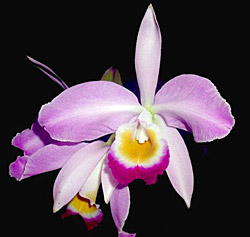 C. eldorado var. typical |
ON: Let us talk about the orchids from the Amazon region! Can you start by Cattleya eldorado? PI:
Cattleya eldorado has a restrict distribution. It occurs in Barcelos,
however it is possible that occurs also in border of Roraima. Unfortunately
I have never collected it there. I collected it in the area of the Balbina
Hydroelectric lake where there was a great occurrence of this species.
With the construction of the lake, big areas of campina (dryland) have
been covered by the water. In this way, many orchids and epiphytes,
in general, died. Unfortunately this hydroelectric provoked a great
environmental impact but not even supply a third of the necessity of
Manaus city. The impact was very big and the cost/benefit isn't worth
while. Tucuruí is worth while but Balbina isn't. |
It
grows on the trees where the water is not retained. It loves a humid
root but doesn't like soaked environments. It prefers well illuminated
places. In cultivation, it does well in pieces of cedar-tree, with good
fertilization and coconut bark, paying attention to the watering or
long-lasting rains. |
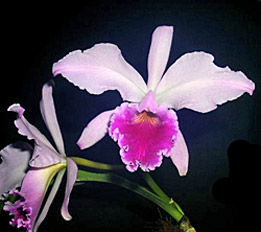 Cattleya jenmani |
There
are two groups of Cattleya eldorado: one occurs in the igapó
(flood forest) and another in campina (dryland) with different season
of blooming. I have the suspect that some populations of Cattleya eldorado crossed with Cattleya jenmani, from Roraima. It can be a process of hybridizing, or there as already a genetic introgression(2) or in those populations there is vicariancy (3). They are different, the plants from the igapó are bigger than those from the dryland. |
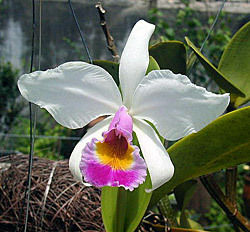 possible hybrid between C. eldorado and C. jenmani |
|
PI: There is a great dispersion of the orchid seeds by the wind because they are very very small. On the other hand, they could migrate through the igapó or from the Campinas by the wind. ON: And the discussion about the validity of the name Cattleya eldorado? P
I: Recently, there are many discussions about this name, if it is a
synonym or not. |
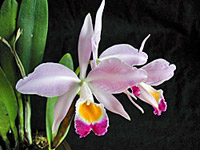 |
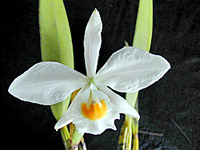 |
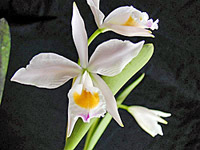 |
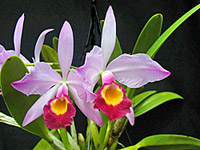 |
C.
eldorado Linden type |
C.
eldorado Linden var. alba Rand |
C.
eldorado Linden var. treyeranae Linden |
C.
eldorado Linden var. lindeni Linden |
ON:
And the conclusions, how long will you take to get them? PI: We already have the technique, in a year, we will analyze all those plants. Now, I am working with a probable natural hybrid or even a new genera, we are analyzing it based on DNA. As I said, the next step is the study of Cattleya eldorado. |
ON:
And about the species you have already described? PI: I described some new species for the science: Pleurothallis kerii; Neolehmannia pabstii; Catasetum kleberianum; Masdevallia osmariniana which has been transferred by Garay & Dunsterville to Dryadella, however, the species they illustrated wasn't the taxon I have described, they misunderstood that species and, probably the material they analyze is a new taxon for the science. |
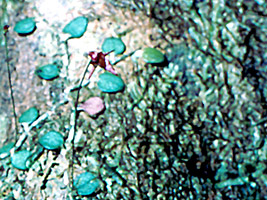 |
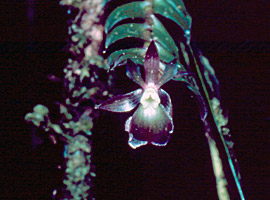 |
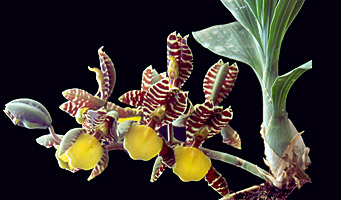 |
Pleurothallis
kerii |
Neolehmannia
pabstii |
Catasetum
kleberianum |
|
Finally, I described X Brassacattleya rubyii, an intergeneric
natural hybrid between Cattleya eldorado and Brassavola martiana.
It has only one specimen known and the plant is there, still alive,
in its natural environment. |
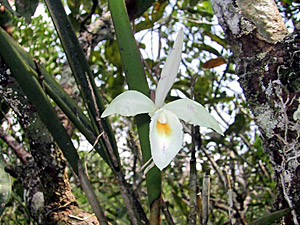 |
X
Brassocattleya rubyii, natural hybrid between C. eldorado
and Brassavola martiana in its habitat in the Campina (Dryland). |
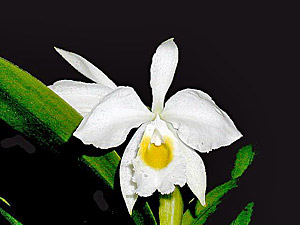 |
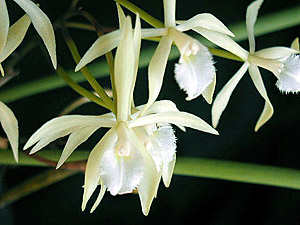 |
Cattleya
eldorado var. alba, one of the probable parents of the hybrid.
|
Brassavola
martiana,
one of the parents |
ON: Just one? And if it disappears one day? PI: We wish to make meristems. The problem of meristem in Amazonas is the fungus. The most of the plant has endophytic fungi. They grow inside the plants and when you put them in a rich salt medium, the fungi dominate it. In the process of polenization, the orchid will take a year to produce the fruit and if the plant is weak, it can die. However, with the system of utilization of immature embryos, things change. With this system, the stigma is fecundated and with 3 months, the embryos can be taking off. It as white mass and from this mass the formation of many protocormes is provoked. Since the embryos would form seeds, everyone would have a genetic identity slightly different from the other and, in this case, we wouldn't have all specimens generated similar to the plant-mother. Then, the embryos are put in liquid medium of culture and put to turn in a special machine in order to remove the polarity of growth. This allows the formation of many calli in each protocorme and they can be minced and put in another medium. When the small plants will be developed and blooming, we will be able to know which material they come from and start to reproduce by the same process. The advantage of this method is that, in three months, the fungi won't contaminate the embryos inside the capsule. This work is finished and will be published. I stayed a year to test all the possibilities and then I oriented a Dissertation of the Master title, and, nowadays we can reproduced any plant, it is just a question of luminosity and pH. ON: In fact, it is a meristem? PI: In the first stage, yes, but not in the second. As a matter of fact, it is a tissue in a embryo phase of growth, which is cut in the middle and put to turn again. To get a meristem from the plant, you have to get a health sprout and that can be harmful for the plant. ON: How are you calling this kind of reproduction? PI: Reproduction through immature embryos. |
| (1) | exsicatae/exsicati is the herborized material with the data collected in the field. |
| (2) | introgression is the introduction of one or more genes of one species into another species, through hybridizing. |
(3) |
vicariancy is the occurrence of a couple of congeneric or subspecies, growing in different habitats of a geographical area but never found in the same community. |